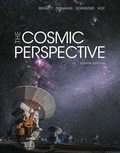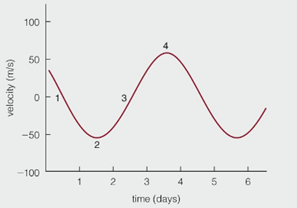
EBK COSMIC PERSPECTIVE, THE
8th Edition
ISBN: 8220101465108
Author: Voit
Publisher: PEARSON
expand_more
expand_more
format_list_bulleted
Concept explainers
Question
Chapter 13, Problem 1VSC
To determine
The time is taken by the star and the planet to complete one orbit around their center of mass.
Expert Solution & Answer
Answer to Problem 1VSC
Solution:
The time taken is 5 days
Explanation of Solution
Given data:
The below figure shows the periodic variations in the Doppler shift of a star caused by a planet orbiting around it. Positive velocities mean the star is moving away from the Earth and negative velocities mean the star is moving towards Earth.

The orbital period for a planet detected by the Doppler method is the time between two points with the same velocity and slope in the velocity-time curve. From the velocity-time graph, we find this time period to be 5 days.
Conclusion:
It takes 5 daysfor the star and the planet to complete one orbit around their center of mass.
Want to see more full solutions like this?
Subscribe now to access step-by-step solutions to millions of textbook problems written by subject matter experts!
Students have asked these similar questions
For each of the actions depicted below, a magnet and/or metal loop moves with velocity v→ (v→ is constant and has the same magnitude in all parts). Determine whether a current is induced in the metal loop. If so, indicate the direction of the current in the loop, either clockwise or counterclockwise when seen from the right of the loop. The axis of the magnet is lined up with the center of the loop. For the action depicted in (Figure 5), indicate the direction of the induced current in the loop (clockwise, counterclockwise or zero, when seen from the right of the loop). I know that the current is clockwise, I just dont understand why. Please fully explain why it's clockwise, Thank you
A planar double pendulum consists of two point masses \[m_1 = 1.00~\mathrm{kg}, \qquad m_2 = 1.00~\mathrm{kg}\]connected by massless, rigid rods of lengths \[L_1 = 1.00~\mathrm{m}, \qquad L_2 = 1.20~\mathrm{m}.\]The upper rod is hinged to a fixed pivot; gravity acts vertically downward with\[g = 9.81~\mathrm{m\,s^{-2}}.\]Define the generalized coordinates \(\theta_1,\theta_2\) as the angles each rod makes with thedownward vertical (positive anticlockwise, measured in radians unless stated otherwise).At \(t=0\) the system is released from rest with \[\theta_1(0)=120^{\circ}, \qquad\theta_2(0)=-10^{\circ}, \qquad\dot{\theta}_1(0)=\dot{\theta}_2(0)=0 .\]Using the exact nonlinear equations of motion (no small-angle or planar-pendulumapproximations) and assuming the rods never stretch or slip, determine the angle\(\theta_2\) at the instant\[t = 10.0~\mathrm{s}.\]Give the result in degrees, in the interval \((-180^{\circ},180^{\circ}]\).
What are the expected readings of the ammeter and voltmeter for the circuit in the figure below? (R = 5.60 Ω, ΔV = 6.30 V)
ammeter
I =
Chapter 13 Solutions
EBK COSMIC PERSPECTIVE, THE
Ch. 13 - Prob. 1VSCCh. 13 - Prob. 2VSCCh. 13 - Prob. 3VSCCh. 13 - Prob. 4VSCCh. 13 - Prob. 5VSCCh. 13 - I. Why are extrasolar planets hard to detect...Ch. 13 - 2. What are the two major approaches to detecting...Ch. 13 - 3. How can gravitational lugs from orbiting...Ch. 13 - Prob. 4EAPCh. 13 - Briefly describe Ihe Doppler method. Summarize the...
Ch. 13 - How does the transit method work’ What was the...Ch. 13 - Prob. 7EAPCh. 13 - Prob. 8EAPCh. 13 - Prob. 9EAPCh. 13 - Prob. 10EAPCh. 13 - Prob. 11EAPCh. 13 - Prob. 12EAPCh. 13 - Prob. 13EAPCh. 13 - Prob. 14EAPCh. 13 - Prob. 15EAPCh. 13 - Prob. 16EAPCh. 13 - Prob. 17EAPCh. 13 - Prob. 18EAPCh. 13 - Prob. 19EAPCh. 13 - Decide whether the statement makes sense lor is...Ch. 13 - Prob. 21EAPCh. 13 - Prob. 22EAPCh. 13 - Prob. 23EAPCh. 13 - Prob. 24EAPCh. 13 - Decide whether the statement makes sense lor is...Ch. 13 - Prob. 26EAPCh. 13 - Prob. 27EAPCh. 13 - Choose Lhe best ansuter to each of the following....Ch. 13 - Choose Lhe best ansuter to each of the following....Ch. 13 - Choose Lhe best ansuter to each of the following....Ch. 13 - Choose Lhe best ansuter to each of the following....Ch. 13 - Choose Lhe best ansuter to each of the following....Ch. 13 - Choose Lhe best ansuter to each of the following....Ch. 13 - Choose Lhe best ansuter to each of the following....Ch. 13 - Choose Lhe best ansuter to each of the following....Ch. 13 - Choose Lhe best ansuter to each of the following....Ch. 13 - Choose Lhe best ansuter to each of the following....Ch. 13 - Prob. 38EAPCh. 13 - Refuting the Theory. Consider the following three...Ch. 13 - Prob. 40EAPCh. 13 - Prob. 41EAPCh. 13 - Prob. 42EAPCh. 13 - Prob. 43EAPCh. 13 - Prob. 44EAPCh. 13 - Prob. 45EAPCh. 13 - Prob. 46EAPCh. 13 - Prob. 47EAPCh. 13 - Prob. 48EAPCh. 13 - Prob. 49EAPCh. 13 - Prob. 50EAPCh. 13 - Be sure to show all calculations clearly and state...Ch. 13 - Prob. 52EAPCh. 13 - Prob. 53EAPCh. 13 - Prob. 54EAPCh. 13 - Prob. 55EAPCh. 13 - Prob. 56EAPCh. 13 - Prob. 57EAPCh. 13 - Prob. 58EAPCh. 13 - Prob. 59EAP
Knowledge Booster
Learn more about
Need a deep-dive on the concept behind this application? Look no further. Learn more about this topic, physics and related others by exploring similar questions and additional content below.Similar questions
- simple diagram to illustrate the setup for each law- coulombs law and biot savart lawarrow_forwardA circular coil with 100 turns and a radius of 0.05 m is placed in a magnetic field that changes at auniform rate from 0.2 T to 0.8 T in 0.1 seconds. The plane of the coil is perpendicular to the field.• Calculate the induced electric field in the coil.• Calculate the current density in the coil given its conductivity σ.arrow_forwardAn L-C circuit has an inductance of 0.410 H and a capacitance of 0.250 nF . During the current oscillations, the maximum current in the inductor is 1.80 A . What is the maximum energy Emax stored in the capacitor at any time during the current oscillations? How many times per second does the capacitor contain the amount of energy found in part A? Please show all steps.arrow_forward
- A long, straight wire carries a current of 10 A along what we’ll define to the be x-axis. A square loopin the x-y plane with side length 0.1 m is placed near the wire such that its closest side is parallel tothe wire and 0.05 m away.• Calculate the magnetic flux through the loop using Ampere’s law.arrow_forwardDescribe the motion of a charged particle entering a uniform magnetic field at an angle to the fieldlines. Include a diagram showing the velocity vector, magnetic field lines, and the path of the particle.arrow_forwardDiscuss the differences between the Biot-Savart law and Coulomb’s law in terms of their applicationsand the physical quantities they describe.arrow_forward
- Explain why Ampere’s law can be used to find the magnetic field inside a solenoid but not outside.arrow_forward3. An Atwood machine consists of two masses, mA and m B, which are connected by an inelastic cord of negligible mass that passes over a pulley. If the pulley has radius RO and moment of inertia I about its axle, determine the acceleration of the masses mA and m B, and compare to the situation where the moment of inertia of the pulley is ignored. Ignore friction at the axle O. Use angular momentum and torque in this solutionarrow_forwardA 0.850-m-long metal bar is pulled to the right at a steady 5.0 m/s perpendicular to a uniform, 0.650-T magnetic field. The bar rides on parallel metal rails connected through a 25-Ω, resistor (Figure 1), so the apparatus makes a complete circuit. Ignore the resistance of the bar and the rails. Please explain how to find the direction of the induced current.arrow_forward
- For each of the actions depicted, determine the direction (right, left, or zero) of the current induced to flow through the resistor in the circuit containing the secondary coil. The coils are wrapped around a plastic core. Immediately after the switch is closed, as shown in the figure, (Figure 1) in which direction does the current flow through the resistor? If the switch is then opened, as shown in the figure, in which direction does the current flow through the resistor? I have the answers to the question, but would like to understand the logic behind the answers. Please show steps.arrow_forwardWhen violet light of wavelength 415 nm falls on a single slit, it creates a central diffraction peak that is 8.60 cm wide on a screen that is 2.80 m away. Part A How wide is the slit? ΟΙ ΑΣΦ ? D= 2.7.10-8 Submit Previous Answers Request Answer × Incorrect; Try Again; 8 attempts remaining marrow_forwardTwo complex values are z1=8 + 8i, z2=15 + 7 i. z1∗ and z2∗ are the complex conjugate values. Any complex value can be expessed in the form of a+bi=reiθ. Find θ for (z1-z∗2)/z1+z2∗. Find r and θ for (z1−z2∗)z1z2∗ Please show all stepsarrow_forward
arrow_back_ios
SEE MORE QUESTIONS
arrow_forward_ios
Recommended textbooks for you
 College PhysicsPhysicsISBN:9781305952300Author:Raymond A. Serway, Chris VuillePublisher:Cengage Learning
College PhysicsPhysicsISBN:9781305952300Author:Raymond A. Serway, Chris VuillePublisher:Cengage Learning University Physics (14th Edition)PhysicsISBN:9780133969290Author:Hugh D. Young, Roger A. FreedmanPublisher:PEARSON
University Physics (14th Edition)PhysicsISBN:9780133969290Author:Hugh D. Young, Roger A. FreedmanPublisher:PEARSON Introduction To Quantum MechanicsPhysicsISBN:9781107189638Author:Griffiths, David J., Schroeter, Darrell F.Publisher:Cambridge University Press
Introduction To Quantum MechanicsPhysicsISBN:9781107189638Author:Griffiths, David J., Schroeter, Darrell F.Publisher:Cambridge University Press Physics for Scientists and EngineersPhysicsISBN:9781337553278Author:Raymond A. Serway, John W. JewettPublisher:Cengage Learning
Physics for Scientists and EngineersPhysicsISBN:9781337553278Author:Raymond A. Serway, John W. JewettPublisher:Cengage Learning Lecture- Tutorials for Introductory AstronomyPhysicsISBN:9780321820464Author:Edward E. Prather, Tim P. Slater, Jeff P. Adams, Gina BrissendenPublisher:Addison-Wesley
Lecture- Tutorials for Introductory AstronomyPhysicsISBN:9780321820464Author:Edward E. Prather, Tim P. Slater, Jeff P. Adams, Gina BrissendenPublisher:Addison-Wesley College Physics: A Strategic Approach (4th Editio...PhysicsISBN:9780134609034Author:Randall D. Knight (Professor Emeritus), Brian Jones, Stuart FieldPublisher:PEARSON
College Physics: A Strategic Approach (4th Editio...PhysicsISBN:9780134609034Author:Randall D. Knight (Professor Emeritus), Brian Jones, Stuart FieldPublisher:PEARSON

College Physics
Physics
ISBN:9781305952300
Author:Raymond A. Serway, Chris Vuille
Publisher:Cengage Learning

University Physics (14th Edition)
Physics
ISBN:9780133969290
Author:Hugh D. Young, Roger A. Freedman
Publisher:PEARSON

Introduction To Quantum Mechanics
Physics
ISBN:9781107189638
Author:Griffiths, David J., Schroeter, Darrell F.
Publisher:Cambridge University Press

Physics for Scientists and Engineers
Physics
ISBN:9781337553278
Author:Raymond A. Serway, John W. Jewett
Publisher:Cengage Learning

Lecture- Tutorials for Introductory Astronomy
Physics
ISBN:9780321820464
Author:Edward E. Prather, Tim P. Slater, Jeff P. Adams, Gina Brissenden
Publisher:Addison-Wesley

College Physics: A Strategic Approach (4th Editio...
Physics
ISBN:9780134609034
Author:Randall D. Knight (Professor Emeritus), Brian Jones, Stuart Field
Publisher:PEARSON